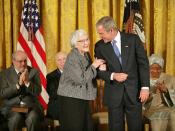To Kill a Mockingbird Criticism
Throughout her 1960 novel To Kill A Mockingbird, Harper Lee employs many literary strategies to perfect her prose. These said methods are difficult to categorize, though it is simplest to divide her methods into three categories, each with their own branching sub-topics. These categories would be Lee's unique writing style, her storyline's structure, and the compelling themes which seamlessly wind their way throughout the book, finding their ways into each and every page, paragraph, and participle.
Lee's style was very individualistic and fascinating. The depth of her words is not immediately absorbed upon initial inspection, but is awe-inspiring upon further perusal. The sheer amount of information given between each line is so quantitative that it raises the uncomfortable question of which specific sub-topic to address first.
Harper Lee's choice of words is unquestionably the most superficial aspect of her style, and thus the easiest to begin with.
This is, of course, not to belittle or discredit the importance of these words, for they serve just as large a role in providing the proper setting to Lee's microcosm.
One of the worthy examples is seen early in the story as Scout and Jem pass the old oak tree whose hollow base occasionally contains presents and treasures for the children. 'Scout' writes, "Jem and I were trotting our orbit..." 'Orbit' is used here to show the how typical this day-to-day habit is, and displays this idea very clearly.
Lee's word choice is again put to use in the next chapter, when Scout catches a snowflake on her tongue and cries out, "Jem, it's hot!" and Jem explains it's not hot, its merely 'so cold it burns." Only a few pages later, Miss Maudie's house is ravaged by flames and burns to the ground.
The word ecclesiastical was...


